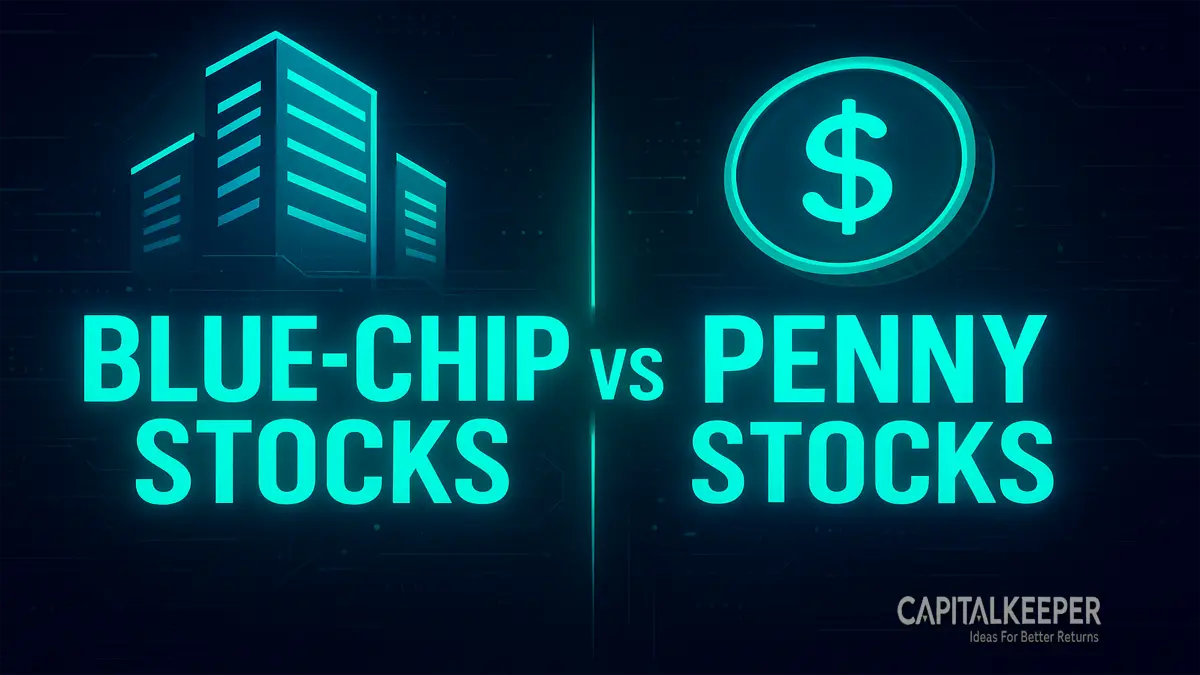Blue-Chip Stocks vs. Penny Stocks – Key Differences Every Investor Must Know
By CapitalKeeper | Beginner’s Guide | Indian Equities | Market Moves That Matter
Introduction
The stock market offers a wide variety of investment opportunities, from well-established multinational companies to tiny firms just getting started. At two ends of the spectrum lie blue-chip stocks and penny stocks.
Blue-chip stocks are known for their stability, reliability, and consistent growth, while penny stocks attract investors with the lure of massive potential returns, albeit at much higher risk. For retail investors, especially beginners, understanding the difference between the two is critical before allocating money.
In this blog, we’ll break down blue-chip stocks vs. penny stocks, explore their characteristics, risks, and potential returns, and discuss which might be more suitable depending on your investment style.
What Are Blue-Chip Stocks?
Blue-chip stocks are shares of large, well-established, and financially sound companies. These companies often have a market capitalization in the billions and operate in industries that form the backbone of the economy.
Key Features of Blue-Chip Stocks:
- Strong Financials: Consistently profitable with steady earnings.
- Reputation: Long track record and trusted brand recognition.
- Dividend Payments: Many blue-chip firms pay regular dividends, offering stable income.
- Low Volatility: Less affected by short-term market fluctuations compared to smaller stocks.
Examples: Reliance Industries, TCS, Infosys, HDFC Bank in India; Apple, Microsoft, Johnson & Johnson in the US.
What Are Penny Stocks?
Penny stocks are shares of small, lesser-known companies, often trading at very low prices (below ₹10–₹20 in India or under $5 in the US). These companies are usually in their early stages or struggling financially.
Key Features of Penny Stocks:
- Low Price: Very cheap per share, making them accessible to small investors.
- High Risk: Limited financial history, lower liquidity, and prone to manipulation.
- Huge Potential Upside: If the company succeeds, penny stocks can generate massive returns.
- Illiquid Market: Difficult to buy and sell quickly without affecting prices.
Examples: Micro-cap companies listed on BSE SME, NSE Emerge, or OTC markets abroad.
Blue-Chip Stocks vs. Penny Stocks: A Side-by-Side Comparison
| Factor | Blue-Chip Stocks | Penny Stocks |
|---|---|---|
| Company Size | Large, established, industry leaders | Small-cap, micro-cap, often unknown |
| Price Range | High (hundreds to thousands of rupees/dollars per share) | Very low (₹1–₹20 in India, <$5 in US) |
| Risk Level | Low to moderate | Very high |
| Return Potential | Moderate but stable (8–15% annually) | High upside, but often 80–90% risk of capital erosion |
| Liquidity | High – easy to buy/sell | Low – thin trading volumes |
| Dividends | Regular dividend payouts | Rarely pay dividends |
| Market Perception | Considered safe havens in portfolios | Viewed as speculative or “lottery ticket” style investments |
| Investor Profile | Conservative to moderate-risk investors | High-risk takers, traders, or speculative investors |
The Case for Blue-Chip Stocks
Blue-chip stocks are often the foundation of long-term portfolios. They are preferred by institutional investors, mutual funds, and pension funds because of their stability.
Advantages of Blue-Chip Stocks:
- Reliable Growth: Provide steady returns over decades.
- Dividend Income: Help generate passive income streams.
- Lower Risk: Safer during market downturns compared to smaller stocks.
- Global Reach: Many are multinational giants with diversified revenue streams.
Example: An investor who bought Infosys shares in the 1990s has seen exponential growth with stock splits, bonuses, and dividends.
The Case for Penny Stocks
Despite their reputation, penny stocks attract investors for their multibagger potential. A single successful penny stock can multiply returns many times over.
Advantages of Penny Stocks:
- Low Capital Requirement: Easy to start investing with a small amount of money.
- High Upside Potential: If the company grows, returns can be 10x–100x.
- Niche Opportunities: Sometimes, innovative or turnaround companies start as penny stocks.
Example: Some small-cap companies in India’s textile and chemical sectors started as penny stocks and grew into mid-cap firms over time.
Risks of Investing in Penny Stocks
While penny stocks may sound appealing, investors must understand the significant risks:
- Price Manipulation: Often subject to pump-and-dump schemes.
- Lack of Transparency: Limited financial disclosures make analysis difficult.
- Liquidity Trap: Hard to exit positions due to low trading volumes.
- High Failure Rate: Many penny stock companies fail or get delisted.
Which is Better for You?
The choice between blue-chip and penny stocks depends on your investment goals and risk tolerance.
- If you’re a long-term investor seeking stable returns and dividends, blue-chip stocks are the safer bet. They protect capital and grow wealth steadily.
- If you’re a high-risk taker looking for quick and massive gains, you might dabble in penny stocks—but only with money you can afford to lose.
A balanced portfolio can include both—blue-chips for safety and penny stocks as speculative bets—but penny stock exposure should be minimal (ideally less than 5% of your portfolio).
Expert Tips for Investors
- Do Your Research: Don’t fall for “hot tips” in penny stocks. Verify fundamentals and promoter track record.
- Focus on Liquidity: Even penny stocks should have decent daily volumes before you invest.
- Diversify Wisely: Rely on blue-chips for core holdings and limit penny stock exposure.
- Use Stop-Losses in Penny Stocks: Protect your downside in case of sharp falls.
- Think Long-Term for Blue-Chips: Hold through cycles for maximum wealth creation.
Conclusion
Both blue-chip stocks and penny stocks have their place in the stock market ecosystem. Blue-chips offer safety, stability, and consistent growth, making them ideal for wealth preservation and long-term planning. Penny stocks, on the other hand, are high-risk, high-reward instruments—best suited for speculative investors who can handle volatility.
The key takeaway is this: blue-chips should form the core of your portfolio, while penny stocks should be approached cautiously and in moderation. By balancing risk and reward, investors can build a portfolio that not only grows wealth but also withstands market turbulence.
📌 For daily trade setups, technical learning, and smart investing tips, stay tuned to CapitalKeeper.in
📌 For more real-time updates, trade setups, and investment insights — follow us on [Telegram] and [WhatsApp Channel] subscribe to our newsletter!

Subscribe Now , Join Telegram the Crypto Capital Club, Get Free Crypto Updates
📌 Disclaimer
The content provided on CapitalKeeper.in is for informational and educational purposes only and does not constitute investment, trading, or financial advice. While we strive to present accurate and up-to-date market data and analysis, we make no warranties or representations regarding the completeness, reliability, or accuracy of the information.
Stock market investments are subject to market risks, and readers/investors are advised to conduct their own due diligence or consult a SEBI-registered financial advisor before making any investment decisions. CapitalKeeper and its authors are not liable for any loss or damage, direct or indirect, arising from the use of this information.
All views and opinions expressed are personal and do not reflect the official policy or position of any agency or organization. Past performance is not indicative of future results.By using this website, you agree to the terms of this disclaimer.
Ranjit Sahoo
Founder & Chief Editor – CapitalKeeper.in
Ranjit Sahoo is the visionary behind CapitalKeeper.in, a leading platform for real-time market insights, technical analysis, and investment strategies. With a strong focus on Nifty, Bank Nifty, sector trends, and commodities, she delivers in-depth research that helps traders and investors make informed decisions.
Passionate about financial literacy, Ranjit blends technical precision with market storytelling, ensuring even complex concepts are accessible to readers of all levels. Her work covers pre-market analysis, intraday strategies, thematic investing, and long-term portfolio trends.
When he’s not decoding charts, Ranjit enjoys exploring coastal getaways and keeping an eye on emerging business themes.
📌 Follow Ranjit on:
LinkedIn | Twitter/X | Instagram | ✉️ contact@capitalkeeper.in
Crypto Market Pulse 14th September 2025: Meme Coins Surge, Majors Show Mixed Moves
















Leave a Reply